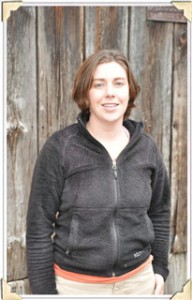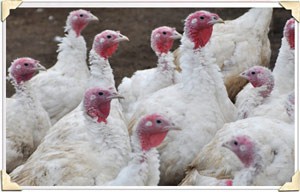November 2011
Dear Farm Aid,
I know that the turkey business is big business come this time of year. This year my family and I are thinking outside the grocer’s freezer case by ordering a local farm fresh turkey. What can you tell me about family farm turkey?
Giving Thanks,
Tom P.
Providence, RI
 To help me answer your question, I visited Kate Stillman, a young farmer in Hardwick, Massachusetts, who raises turkeys, in addition to cattle, pigs, chickens, lambs and a few goats (not to mention an adorable three-year-old!). Raised as a third-generation farmer, Kate always knew she wanted to farm. She didn’t set out to raise turkeys, not even when she purchased a farm called The Turkey Farm in 2005. She thought she’d change the name, but on the first day in her new town she bumped into a man who said, “Oh, you bought The Turkey Farm… my grandmother always told stories about going up to the Farm every Thanksgiving to help with the turkey slaughter.” It seemed to be a sign so Kate merged her family’s agricultural legacy with that of her beautiful piece of land to come up with its new name: Stillman’s at the Turkey Farm. Her first turkey flock was small since she wasn’t familiar with turkeys, but this year finds about 500 turkeys at Stillman’s at the Turkey Farm!
To help me answer your question, I visited Kate Stillman, a young farmer in Hardwick, Massachusetts, who raises turkeys, in addition to cattle, pigs, chickens, lambs and a few goats (not to mention an adorable three-year-old!). Raised as a third-generation farmer, Kate always knew she wanted to farm. She didn’t set out to raise turkeys, not even when she purchased a farm called The Turkey Farm in 2005. She thought she’d change the name, but on the first day in her new town she bumped into a man who said, “Oh, you bought The Turkey Farm… my grandmother always told stories about going up to the Farm every Thanksgiving to help with the turkey slaughter.” It seemed to be a sign so Kate merged her family’s agricultural legacy with that of her beautiful piece of land to come up with its new name: Stillman’s at the Turkey Farm. Her first turkey flock was small since she wasn’t familiar with turkeys, but this year finds about 500 turkeys at Stillman’s at the Turkey Farm!
This year, Kate raised two breeds of turkey: the popular White Broad Breasted and the heritage Blue Slate. Kate gets poults (turkey chicks) from local breeders in July. Until this year, she had to mail-order the heritage breed turkeys from as far away as Montana, but she recently made a connection to a local breeder to get the Blue Slates from just a few towns over. The turkeys spend the summer and fall fattening on pasture and grain. They enjoy insects and can mow a beautiful lush lawn to dirt in just a few weeks! Kate’s turkeys enjoy the shelter of a plastic greenhouse that gives them access to pasture and a warm place to sleep at night.
In just a couple days, the turkeys will be loaded up and taken to a USDA-certified poultry slaughtering facility in Vermont. It’s two hours away, but it is the closest USDA poultry-certified slaughterhouse to Kate’s farm. The loading will begin a week before Thanksgiving at 10 pm, so that Kate and her crew can be first in line when the facility opens. On this small farm scale, Kate and her employees are part of the process of processing—they’ll be at the slaughterhouse the whole time, bringing turkeys in, and then getting the turkeys packaged, labeled and packed up. Kate’s customers will come from all over to pickup their fresh turkeys at various locations around Boston and it won’t be until Tuesday evening, after the last big pick up, that Kate and her team can head back to the farm to toast another successful turkey harvest with a well-earned bottle of champagne.
I ask Kate and her team if they like the turkeys. It’s pretty much a resounding no. But Kate explains that there’s a way in which raising the turkeys brings the farm together for a big holiday push that has its own rewards. She says, “Honestly, with all the extra work that’s involved in making sure 400 orders are placed and confirmed, I don’t know if the farm truly makes a dime on the turkeys.” But she explains her team takes great pride in raising their flock, and all of their animals. And though she’s modest in that sensible farmer way, she does too—I can tell when she tells me how the employees at the slaughterhouse all wanted to buy her turkeys for their own meals after they saw how good Kate’s turkeys looked. She didn’t have any to spare—they’d all been ordered—but oddly she ended up a few short that year and she has a sneaking suspicious the slaughterhouse employees enjoyed her turkeys anyway!
Why local turkey? For all the reasons we at Farm Aid talk about often—to keep local farmers thriving, to keep farmland in production instead of in development, to support our local economies, for the goodness of food raised by folks who truly care about it and the environment, for our health, for better taste. For Kate, it’s about the taste. She says once folks have that fresh turkey, they won’t want another frozen one.
 Kate has some tips for folks cooking their first farm-fresh turkey. She says that her turkeys cook up quicker (and this is especially true for the heritage breeds), because they’re not as dense. As she puts it, “At the grocery store, you’re not buying meat, you’re buying a ‘meat product’ that’s pumped with a lot of extra stuff.” This year Kate has teamed up with another successful local food entrepreneur, offering side dishes like mushroom gravy and pumpkin pie filling that help Kate’s customers bring farm-fresh food to the table. And this weekend, the farm will open up to the community for a pre-Thanksgiving feast featuring the bounty of all three Stillman farms. It’s a celebration of local food, and the farmers and supportive communities that make that good food possible.
Kate has some tips for folks cooking their first farm-fresh turkey. She says that her turkeys cook up quicker (and this is especially true for the heritage breeds), because they’re not as dense. As she puts it, “At the grocery store, you’re not buying meat, you’re buying a ‘meat product’ that’s pumped with a lot of extra stuff.” This year Kate has teamed up with another successful local food entrepreneur, offering side dishes like mushroom gravy and pumpkin pie filling that help Kate’s customers bring farm-fresh food to the table. And this weekend, the farm will open up to the community for a pre-Thanksgiving feast featuring the bounty of all three Stillman farms. It’s a celebration of local food, and the farmers and supportive communities that make that good food possible.
Come Thanksgiving, Kate’s table will serve nineteen—including her family and the crew of her farm and the farms of her brother and father. She says, “Our meal is probably as close to the first Thanksgiving as possible because we truly are giving thanks for the harvest. Everything on our table we grew or raised ourselves. It sustains us.” And it also sustains hundreds of other families, who send photos of the beautiful meals the Stillmans and their crew helped make possible through their hard work.
It’s back to work after the holiday, as a livestock farm never truly stops working. Kate’s CSA and farmers market customers keep her busy throughout the year. She’s been working for this her whole life, growing up on a farm, working the farmers market with her dad since the age of 11. She says her dad never sheltered his kids from anything farm-related—good or bad. She credits that experience with her ability at age 30 to be a successful young farmer. And for that she gives thanks.

